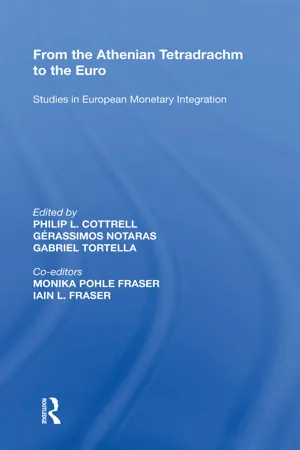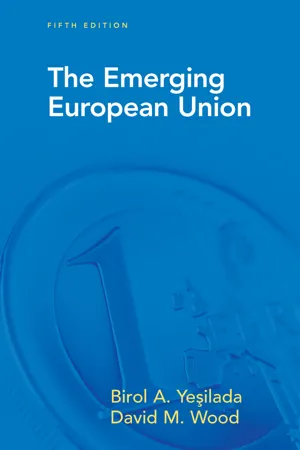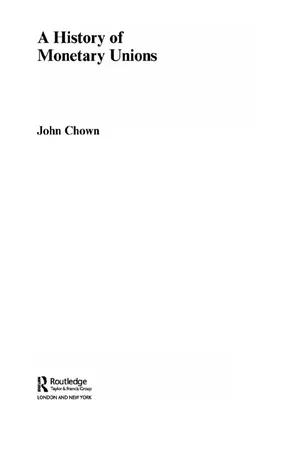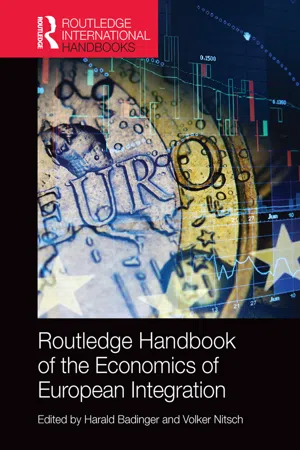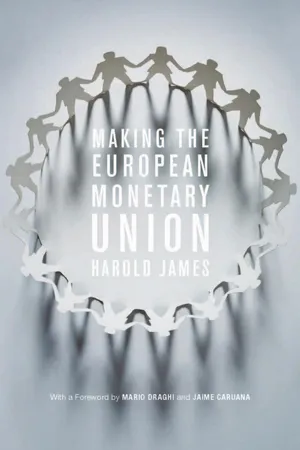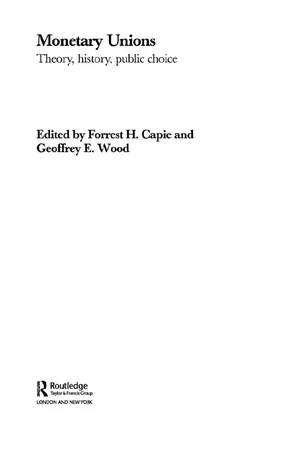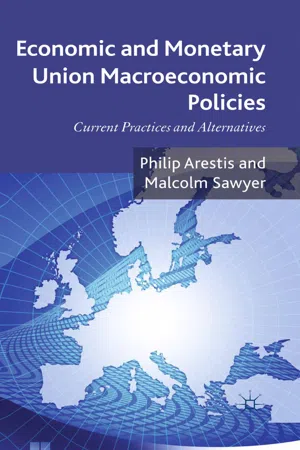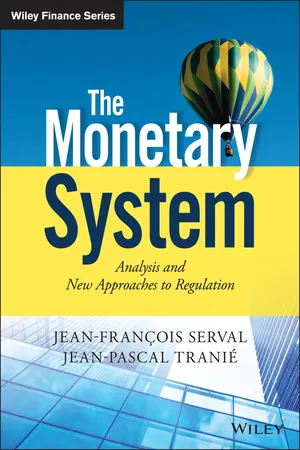Economics
European Monetary System
The European Monetary System (EMS) was an arrangement established in 1979 to stabilize exchange rates and facilitate economic cooperation among European Union countries. It included the European Currency Unit (ECU) as a unit of account and the Exchange Rate Mechanism (ERM) to manage currency fluctuations. The EMS laid the groundwork for the Economic and Monetary Union and the introduction of the euro.
Written by Perlego with AI-assistance
Related key terms
11 Key excerpts on "European Monetary System"
- eBook - ePub
From the Athenian Tetradrachm to the Euro
Studies in European Monetary Integration
- Gérassimos Notaras(Author)
- 2017(Publication Date)
- Routledge(Publisher)
The European Monetary System 1Michael ArtisIntroduction
By any standards the European Monetary System (EMS) was a remarkable invention. It can now be seen to have paved the way for the creation of European Monetary Union. Yet that ambition did not figure in the declarations with which the EMS was launched in 1979. It began life as a response to a distrust of American leadership of global monetary affairs. Its immediate aim — to create a zone of monetary stability in Europe — seemed relatively modest. EMS arrangements conveyed a desire to do this on a symmetric basis, and it was hailed as an innovator in this respect.Early experience caused one influential observer (Samuel Brittan of the Financial Times ) to describe the EMS as 'a mere crawling peg'. Yet, not much later, the French government had performed the Mitterand 'U-turn', the EMS turned into a counterinflationary framework and the investment in symmetry was liquidated in favour of pegging the Deutschmark (DM), provoking a new description of the EMS as (merely?) 'a Greater DM Area'.Of course, this evolution just mirrored the transition of industrial economies at large from a 'Keynesian' to a 'monetarist' orientation, with the modification that the nominal anchor that monetarism proposed to find in the money supply, or its growth rate, could be found in the exchange rate. Put slightly differently, it seemed possible to import the reputation of the low-inflation partner through pegging the exchange rate, saving time on the alternative creation of a counter-inflationary reputation at home. This passage to the era of the 'hard EMS' involved the residual use of the flexibility that it provided, and before the speculative crises of 1992 and 1993, EMS was advertised as a paragon among exchange-rate systems — hard yet flexible, preserving conditions of competitiveness from arbitrary misalignment yet also projecting a counter-inflationary influence. It appeared capable of making these gains even while capital controls were liberalized. Realignments had been effected without exciting ruinous speculation. With this record, it came to serve as a model for exchange-rate system 'blueprints' at the global level. - eBook - ePub
- Birol Yesilada, David Wood(Authors)
- 2015(Publication Date)
- Routledge(Publisher)
9Economic and Monetary Union
The history of the Economic and Monetary Union (EMU) represents a bold adventure that carries with it political and economic risks. With a single monetary authority and a single European currency, the euro (€), replacing the national banknotes and coins of 16 member states, the EMU represents the climax of European economic integration. In this chapter, we will provide an overview of the regional and systemic developments that gave rise to the coordination of exchange rate policy in the European Union (EU) countries, followed by an analysis of the “snake in a tunnel” and the failure of the members to achieve a zone of monetary stability in Europe. We will then examine the European Monetary System (EMS) and the EMU. Finally, we will analyze the economic and political implications of EMU for member states and the global monetary system.After the creation of the customs union and until the adoption of the EMS in 1978, members of the European Community (EC) experienced serious economic difficulties that threatened the future of economic integration. Whereas many scholars argue that this was a period of disintegration, we believe that this conclusion is misplaced (see Chapter 4 ). If disintegration was the order of this period, then how can one account for the creation of the EMS, which highlighted a process of trial and learning in exchange rate policy? Moreover, the European Regional Development Fund (ERDF) came into effect in 1975. As we will explain in Chapter 10 , this fund was crucial for the development of the underprivileged regions of the EC. Finally, the EC expanded to nine countries when Britain, Denmark, and Ireland became members in 1973.The economic difficulties experienced by the EC resulted from important changes in the international economic order. The collapse of the Bretton Woods monetary system represented the first serious shock to the EC and tested its seriousness in achieving economic integration. During the 1960s, there were important developments that weakened this monetary system. The weakening of the U.S. dollar strained the stability of European currencies: The West German government revalued the deutsche mark (DM) in 1961 and 1969, and the French government devalued the franc in 1969. These measures were intended to stabilize the U.S. dollar in international markets. However, they failed to eliminate exchange rate instability in the system and persuaded EC leaders that alternative policy options had to be considered for the EC. The policy recommendation came at the Hague summit of 1969, where the EC heads of state and government accepted Willy Brandt’s call for EMU. Subsequently, the Werner plan of 1970 laid down the basic idea for this monetary union.1 - eBook - ePub
The European Union Illuminated
Its Nature, Importance and Future
- A. El-Agraa(Author)
- 2015(Publication Date)
- Palgrave Macmillan(Publisher)
The EMS was the next step towards the EMU, but it was devised to counter the monetary upheavals of the 1970s by creating a ‘zone of monetary stability’. The route to the EMS was a fairly short one. The idea was floated not by the Commission, but by the German chancellor, Helmut Schmidt, and the French president, Valéry Giscard d’Estaing, and was discussed in the Council in Copenhagen in April 1978. Roy Jenkins, Commission president, had called for such a corrective initiative in a speech in Florence the previous October. By 5 December the Council had adopted the idea, in the form of a resolution ‘on the establishment of [EMS] and related matters’, after a period of intensive discussion.The EMS, which started operating in March 1979, was introduced with the immediate support of six of the EC Member States at the time. Ireland, Italy and the UK adopted a wait-and-see attitude. Ireland and Italy needed ‘time for reflection’, which required a broader band of permitted fluctuation of ±6 per cent when they did enter, and the UK expressed a definite reservation. Later, Ireland and Italy joined the system, while the UK expressed a ‘spirit of sympathetic cooperation’.The main features of the EMS, given in the annex to the conclusions of the EC presidency;21 are set out in Box 6.1.In essence, the EMS is concerned with the creation of an EC currency zone within which there is discipline for managing exchange rates. This discipline is known as the ‘exchange rate mechanism’ (ERM), which asks a member nation to intervene to reverse a trend when 75 per cent of the allowed exchange rate variation of ±2.25 per cent is reached. This is similar to what happened within the preceding ‘snake’ arrangements. The crucial differences were, however, twofold. First was the creation of the ECU as the centre of the system against which divergence of the exchange rate was to be measured. The ECU followed on directly from the European Unit of Account as a basket of all EC currencies, not just those participating in the ERM (1ECU = 1EUA). Weights in the basket, based on economic importance in the system, were revised every five years.22 - eBook - ePub
- John F Chown(Author)
- 2003(Publication Date)
- Routledge(Publisher)
The Tindemanns Report was described as ‘vague’ and the general mood in the 1970s was one of pessimism about both monetary and political union. It suggested approaching monetary union on the basis of the Snake and existing treaties. In early 1978 Roy Jenkins, then a European Commissioner, said that he looked for a more important role for EMU, and the creation of more stable relationships within the international monetary system. At a Bremen summit in June 1978:Germany, supported by the Netherlands, had always regarded monetary union as the crown on economic convergence, by contrast with France which – together with the United Kingdom and the European Commission – mainly considered monetary unification as the driving force of economic convergence.8On 1 November 1975 the Economist published the All Saints Day Manifesto, advocating the introduction of a parallel currency, discussed, with other similar proposals, in Chapter 40.The Bremen meeting put forward a proposal which would lead to a ‘zone of monetary stability’, and following this initiative it was decided to introduce the European Monetary System on 1 January 1979 (it was in fact delayed until 13 March because of French problems with the Common Agricultural Policy). The transitional stage was intended to end after two years, but there was no indication of any long-term goal of full monetary union.The European Monetary System had three aspects:- The European Monetary System had an arrangement for pegging the exchange rates of member countries
- a system of credit facilities to help defend the rates and
- a ‘European Monetary Fund’.
The European Currency Unit
The Ecu (European Currency Unit) was introduced on 13 March 1979 as a successor to the European Unit of Account, but had a much more central role, notably in the arrangements for the EMS. The Ecu (like the EUA and indeed like the SDR) was defined as a weighted average of member states’ currencies. It was not, at this stage, envisaged that the Ecu would take the place of national currencies. When introduced, the deutschmark constituted about 33 per cent, and sterling about 13 per cent, of the Ecu basket. The composition was amended from time to time, the final changes being in September 1989. As from November 1993 it was ‘frozen’; there were to be no more changes, which, incidentally, meant that the currencies of Austria, Finland and Sweden were not included. (When most of the component currencies adopted the euro, the Ecu continued to exist as a basket of the euro, plus the pound sterling and the Danish krone.) - Harald Badinger, Volker Nitsch, Harald Badinger, Volker Nitsch(Authors)
- 2015(Publication Date)
- Routledge(Publisher)
But in practice, the Snake proved impossible to operate on an EEC basis, as speculative pressures built of because of mutually incompatible policy regimes. Britain left the snake mechanism less than two months after joining. Ireland, which was in a currency union with the UK, also left at the same time; Denmark, with very extensive trade links with the UK announced its departure on June 27, 1972, but kept the krona within the Snake limits and actually rejoined on October 10. France left the Snake on two occasions; and the Scandinavian countries were forced to abandon their membership too. The result was that the Snake soon looked like a really small currency zone around Germany – with only the Netherlands as a consistently reliable member.4 The EMS
In 1978, the European monetary regime was remade. The major initiative came from French President Valéry Giscard d’Estaing and German Chancellor Helmut Schmidt. Their high level debates were charged with lofty geo-political thoughts, and the new monetary arrangements were frequently seen as a challenge to the role of the dollar, which they believed was being deliberately depreciated (in a so-called “malign neglect”) against other currencies in order to obtain trade advantages.The eventual outcome of the intense negotiations of 1978, the European Monetary System (EMS) is often regarded as a transformative step on a progressive path to monetary integration (Ludlow 1982 ). But in practice it amounted to little more than an elegant repackaging of the Snake arrangements, a “swimming trunk” cover up of the bare essentials as Helmut Schmidt contemptuously put it when addressing the German Bundesbank; to soothe French susceptibilities about having been twice ejected ignominiously from that arrangement?Like the Werner Plan, it began with a suggestion from the EC Commission, whose President, Roy Jenkins, saw the issue of Europe’s currency arrangements as primarily a response to the faltering and flawed character of American monetary hegemony, and the strains that were consequently imposed on Europeans (Jenkins 1977 ).Members of the new EMS exchange-rate mechanism were obliged to intervene without limits at the 2.25 percent fluctuation margins either side of a central parity calculated bilaterally on the basis of a central rate calculated around a basket currency (European Currency Unit, ECU), which was to be “at the centre of the EMS” (so that there would be no national currency like the Deutschemark as the basis of the peg). Central rates could be adjusted “subject to mutual agreement by a common procedure which will comprise all countries participating in the exchange-rate mechanism and the Commission.” A divergence indicator of 75 percent of the maximum spread of each currency would, when attained, allow the identification of the country which was diverging, and then trigger corrective action (Mourlon-Druol 2012- eBook - ePub
- Wilfried Loth(Author)
- 2015(Publication Date)
- De Gruyter Oldenbourg(Publisher)
The proposal from Schmidt for increased use of the European Unit of Account was made more precise to the effect that it was to constitute the “core” of the improved monetary arrangement, that is, it was not only to serve as a means to simplify payments between the central banks but also serve as the basis for the interventions to preserve the bandwidths. The Franco-German paper, in which the thoughts of Belgian central banker Jacques van Ypersele had been incorporated, therefore spoke of a “European Currency Unit" (ECU) and a “European Monetary System” (EMS) that went beyond the snake. Regarding the sought-after merging of currency reserves, it was said that “e.g. 20%” of the member states' currency reserves in dollars and gold was to be placed in the European Monetary Cooperation Fund and, additionally, “an amount of comparable order of magnitude” in the currencies of the member states. When purchasing dollars, about twenty percent was likewise to be placed in the common Cooperation Fund; when selling dollars, the central banks would receive about twenty percent in European Currency Units. Regarding usage of EMS funds made up of deposits of member states' currency assets, it was rather ominously the case that it “will be subject to conditions varying with the amount and the maturity; due account will be given to the need for substantial short term facilities.” Clearly, the authors envisioned an expansion and simplification of credits to member states that had come under pressure to devalue - eBook - ePub
- Mark Baimbridge, Philip B. Whyman(Authors)
- 2016(Publication Date)
- Routledge(Publisher)
Part II EMU: Theoretical ConsiderationsPassage contains an image
Chapter 5 An Overview of European Monetary Integration
DOI: 10.4324/9781315570037-5Introduction
The advent of a single currency covering the majority of European Union (EU) member states was a momentous event that will have profound consequences for people across the Continent and beyond. The euro has become the currency in which individual citizens are paid and denote the price of all goods, services and labour across the whole Economic and Monetary Union (EMU) zone. Thus, a coin minted in France is legal tender in Germany, Italy and Belgium, creating a greater transparency of transactions in the process. More importantly, monetary union required the transfer of monetary and exchange rate policy from each participating nation state to a central authority, in this case the European Central Bank (ECB) based in Frankfurt, which operates a uniform monetary policy for the entire single currency region. Therefore, Finland, Spain and the Netherlands each have an identical interest rate, set by the ECB for the benefit of the participating nations as a whole. In addition, to ensure that divergent fiscal policy does not destabilise the currency union, individual countries are subject to commonly accepted constraints upon their budget deficits that, if they were to rise above a target rate of between 1 and 3 per cent, theoretically results in the country being fined by the EU. Thus, discretionary national macroeconomic management has been largely superseded by rule-based economic co-ordination, intended to sustain monetary union whilst creating ever-closer economic union between participating member states. Consequently, methods of economic management and democratic accountability have been fundamentally altered. - eBook - ePub
- Harold James(Author)
- 2012(Publication Date)
- Belknap Press(Publisher)
9 The EMS CrisesThe road from the Delors Committee and the Maastricht Treaty to monetary union was quite rough. Five years of stability after 1987, when the last realignment had taken place and the EMS was apparently strengthened by the Basel-Nyborg Agreement, were followed by a dramatic shock. Suddenly everything seemed to fall apart. In 1992–1993 the European monetary order appeared fundamentally endangered by a series of dramatic exchange crises that began in peripheral countries, Italy and the United Kingdom, and then affected nonmembers of the EC in Scandinavia as well as new members of the EMS, Spain and Portugal. France, pursuing a policy of the strong franc (franc fort), had tied itself to Germany and initially seemed secure. But by the end of the process of contagion, France was also endangered: thus the central Franco-German relationship that had formed the core of the integration project was now vulnerable. In the end, the experience of crisis was good for Europe and for the European process, and a crisis summit produced a workable outcome that allowed more room for flexibility while keeping to the road to monetary union.There were three elements of crisis that were interwoven in the early 1990s. First, there was a geopolitical discussion as a result of the surprise of German unification. The new increase in German power as a result of the addition of some 16 million new Germans prompted other countries to think of institutional ways of limiting the new German strength. Second, there was a technical crisis of the exchange rate system, which seemed to refute a widespread technocratic and academic but also market assumption that the EMS/ERM rates had reached a state of quasi-permanency. Third, there was the long-standing global issue of the role of the dollar and the problems it posed for the international financial order. The detailed narrative of how these elements interact shows some characteristic signs of the complex European system of bargaining between states, central banks, and a wide variety of institutionalized social and political factors. Problems were made worse by a long-running denial of the real problems, and the repeated enunciation of convictions that political will and the European dream could be a substitute for economic policy convergence. The advantage of secret meetings was that they could give central bankers an opportunity to diverge from the optimistic script and to air their concerns: but those discussions were also constrained by fears of leaks that might (and eventually did) produce explosive crises of confidence. At the very last moment, also in a standard scene of the European political drama, shaken by the real possibility of failure, countries reached an agreement that rescued the system by injecting a new element of flexibility. - eBook - ePub
- Forrest Capie, Geoffrey E Wood(Authors)
- 2003(Publication Date)
- Routledge(Publisher)
3 The future of EMU
What does the history of monetary unions tell us?
Michael D. Bordo and Lars JonungIntroduction
On 1 January 1999 the exchange rates of eleven members of the European Union were locked to each other at irrevocably fixed rates. This was a major step towards the establishment of the European Monetary Union (EMU) and the European Central Bank (ECB). The eleven domestic currencies has been replaced by one single currency, the euro. It circulates in an economic region probably larger than that of any other currency area. 1 January 1999 marks an important transition not only in the history of Europe but in the history of the global monetary system.The creation of EMU and the ECB has triggered a discussion of the future of EMU. Independent observers have pointed to a number of shortcomings, ‘flaws’ or ‘hazard areas’ in the construction and workings of EMU. These include (1) the absence of a central lender of last resort function for EMU, (2) the lack of a central authority supervising the financial systems of EMU, (3) weak democratic control (accountability) of the ECB, (4) unclear and inconsistent policy directives for the ECB, (5) the absence of central co-ordination of fiscal policies within EMU combined with unduly strict criteria for domestic debt and deficits as set out in the Maastricht rules and the Stability Pact in the face of asymmetric shocks, and (6) Euroland is not an ‘optimal’ currency area. The list can be lengthened.Do these shortcomings represent major threats to the future of EMU? Will they eventually spell the demise and break-up of EMU? Or will they be handled by the European policy authorities in a successful way, leading to a lasting and prosperous EMU?We answer these questions by examining the historical record of a number of unions that have turned out to be lasting as well as some unions that have been dissolved. Our aim is to extract the key conditions for the establishment and survival of monetary unions. Our interpretation of the historical record serves as the basis for our forecast for the future of EMU, although we are well aware that there is no clear precedent to EMU. While by now the literature on monetary unions and European monetary co-operation is voluminous, there are few systematic studies dealing with the stability or sustainability of monetary unions and monetary integration.2 - eBook - ePub
Economic and Monetary Union Macroeconomic Policies
Current Practices and Alternatives
- P. Arestis, Kenneth A. Loparo(Authors)
- 2013(Publication Date)
- Palgrave Macmillan(Publisher)
4 Monetary Policy in the Economic and Monetary Union 4.1 IntroductionOur main focus of attention in this and the next chapter is on the EMU macroeconomic policy frameworks. We discuss monetary policy as implemented by the ECB in this chapter, and this is followed in chapter 5 by a discussion of the fiscal policy aspects of the Economic and Monetary Union (EMU). In this chapter we set out the specific elements of the monetary policy of the EMU, and consider the strengths and weaknesses of this policy as applied within the EMU.We examine in this chapter the institutional framework of monetary policy along with the strengths and weaknesses of the theoretical and empirical aspects of this policy. We begin by discussing monetary policy itself in section 4.2, and this is followed in section 4.3 by a discussion of inflation problems. In section 4.4 we discuss problems with economic activity; this is followed in section 4.5 by a discussion of the potential future of monetary policy developments. Finally in s ection 4.6 we offer a number of concluding remarks.4.2 Monetary policyWith the formation of the EMU, monetary policy has been removed from national authorities and from political authorities and placed with the ECB – that is, the ECB is not only supranational but also ‘independent’ of political (or other) authorities. The ECB and the national central banks are linked into the European System of Central Banks (ESCB) with a division of responsibility between them. The ECB has the responsibility for setting interest rates in pursuit of the inflation objective and the national central banks responsibility for regulatory matters.The ECB is set up to be independent of the European Union (EU) Council and Parliament and also of its member governments. There is, thus, a complete separation between the monetary authorities, in the form of the ECB, and the fiscal authorities, in the shape of the national governments comprising the EMU. It follows that there can be little coordination of monetary and fiscal policy. Indeed, any attempt at coordination would be extremely difficult to implement. For apart from the separation of the monetary and fiscal authorities, there is also the constitutional requirement that national governments (and hence the fiscal authorities) should not exert any influence on the ECB (and hence the monetary authorities). Any strict interpretation of that edict would rule out any attempt at coordination of monetary and fiscal policies. Nor is it desirable to co-ordinate fiscal and monetary policy in the view of the ECB: - eBook - ePub
The Monetary System
Analysis and New Approaches to Regulation
- Jean-François Serval, Jean-Pascal Tranié(Authors)
- 2014(Publication Date)
- Wiley(Publisher)
The Triffin paradox is a key issue, Europe being an example of a political set-up where finance people, politicians and citizens have contradictory perspectives. The strong macroeconomic data of the zone, combined with stable national political systems and a new unknown centralized governance system with the Banking Union, leads automatically to a strong euro that US critics push to reinforce. Suddenly, we have a pattern that, with the dollar still transnational, at least for transactions, leads to increased instability and erratic risk of speculation, which is unsustainable by the USA because of its smaller size compared with other zones. Everyone may, one day, have to reconvene as a case of urgency or collapse similar to what happened in 2007.Money, as opposed to other matters, needs to be used as widely as possible to favour exchanges, and one has to remember that the harsh British devaluation of 1931 was only determined by the absence of recovery both in Europe and America. While there is no sign of convergence and of any strategy to converge as encouraged by the G20, there is a stringent requirement to achieve monetary global governance.THE MONETARY INTERACTION OF SYSTEMS
General Interaction: Scale Economies Resulting from Monetary Integration and Political Obstacles
With exchanges requiring trust, there is a need for guarantees as to the measurement tool of prices and also the fairness of markets. Surveillance addresses the fairness, but still does not globally address the question of foreign exchange, measurement and aggregates even if the FSB is there to raise the issues. Markets not being perfect, there is a need for action and sanctioning over the available volume of money and its trading prices.It has been said that there would be no history of monetary unification success where there was no political unity to drive a single or coordinated budget policy for governments. The given examples of success are Switzerland (Swiss franc, 1815) and Germany (1870). Europe evidently had an issue over, like the US Federation, having member states with totally different production and budget patterns but less (than the USA) political integration. The almost completed free market zone, like the US one, aggravates the problem of money flowing to the safest places and the safest institutions. The structural differences in economies and development stages that have been addressed by structural European funds to help less developed regions and countries have not addressed the fact of remaining structural production advantages that some regions have compared with others. In the absence of sufficient means and of a unified banking supervision and intervention tool, excess money existing all over the world and being free to speculate is a threat to the single currency, despite positive aggregates. The saying (Gresham law) that “bad money pushes good out” may be true. The above new oversight set-up is addressing the insufficiencies that appeared in the field after the 2007 crisis broke out. The banking union treaty, the new intervention set-up already decided on, is to address the issue of a centralized back-up for the single currency, like the dollar already has. Where the difference with the USA will remain is in the time elapsing. Because of the ongoing integration process with scale economies in an already achieved single market, all industries have to become bigger, meaning some have to become the consolidators and others the consolidated. Of course, companies becoming regional when they have been national, or becoming national after having been only regional, or just quitting, requires reorganization, adaptations and suffering. Productivity means fewer staff for the same production. It cannot be done in one day, and also favours centres with competitive advantages, meaning transfers at the expense of population. It is, on another scale, the whole debate about globalization.
Index pages curate the most relevant extracts from our library of academic textbooks. They’ve been created using an in-house natural language model (NLM), each adding context and meaning to key research topics.
